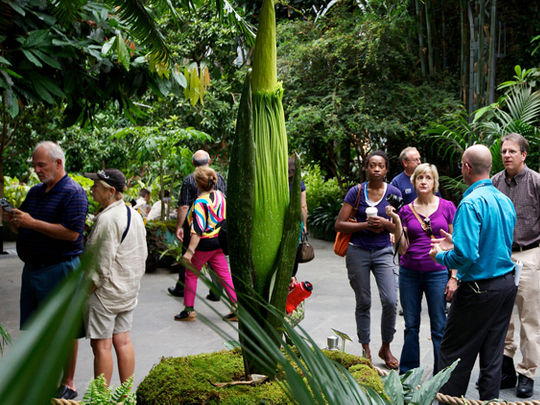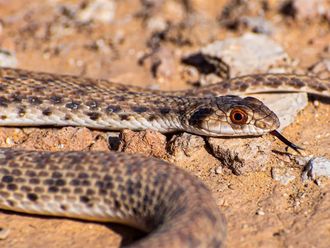
Washington: Bizarre, lurid and simply huge, the world’s largest flower stands poised to do its Elvis act at the US Botanic Garden.
As early as Monday or later in the week, its pleated crimson cape will peel back to reveal a central stalk with a secret weapon for drawing pollinators. The King may have had his gyrations, but the titan arum emits a stench designed to lure carrion insects from miles around. In this case, the stink is expected to entice thousands of humans, as word spreads that this rare event is unfolding in the garden’s ornate conservatory at the foot of the US Capitol.
The garden is extending its hours until 8pm so that more people can get a view of this strange floral beast and perhaps get a whiff of its sickening scent, which doesn’t appear until after it has opened and reaches its worst the first night after flowering.
“Like a very dead elephant,” said Elliott Norman, the gardener who has been growing it since 2005, when it was the size of a pea. Its tuber alone may weigh as much as 90 pounds.
In the warm, muggy environment of the conservatory’s lush Garden Court, the flower is growing by the hour. Its height on Saturday was 5 feet 2 inches, but it had grown another five inches by midday on Sunday. It was noticeably plumper too, but as a steady stream of admirers came by hoping to see and smell it in its full glory, the titan arum made it plain that it will do its thing when it is ready. It had suddenly become Washington’s version of the Royal Baby Watch.
“I was hoping to smell it,” said Nicole Dinion, 25, a member of the national rowing team who is based in Oklahoma City. She had cycled nine miles from Falls Church, Virginia, with her mum and step-dad to see the bloom. “I might come back tomorrow.”
Paige Gance, 22, a summer intern in Washington and a recent graduate of Washington and Lee University, said she was “kinda bummed that it isn’t in bloom yet, but it’s pretty neat.” She arrived with her friend Zander Tallman, a rising senior at the same university.
“I don’t think I’ll ever get another chance to see one of these things,” she said. “Though I’m a bit nervous about how bad it smells.”
For botanical gardens, the arum’s appearance is a boon, as well as a money-spinner for those that charge admission (the US Botanic Garden, at 100 Maryland Ave. SW, is part of the Capitol complex and is free to visit). Although the arum is not as rare in the West as it once was — this is the fourth display of an arum in Washington in the past 11 years (two grown by the Smithsonian) — its appearance still has the capacity to draw crowds and media attention.
“It’s the Botanic Garden’s panda,” said Norman. He was speaking on Friday, the day after the giant was transported very carefully from the institution’s production greenhouses in south-east Washington. Still furled but big and weird, the arum drew smiles and some eye-bulging glances from a gathering crowd. “Are you the grower?” a middle-aged woman asked Norman as she took a picture. “Congratulations.”
While pandas appear cuddly, the titan arum has a more pernicious and suggestive quality about it. (Its botanic name is Amorphophallus). It comes from the sultry, steamy jungles of Sumatra, and once it opens, it begins to pulsate with heat, so that its rotten smell convects up and away to distant dung and carrion beetles. It is sometimes called the ‘corpse flower’, and while a species of palm tree has a complex, candelabra-like inflorescence that extends much farther than that of the Sumatran giant, the titan arum ranks as the biggest unbranched bloom on the planet.
The actual size varies by individual and the age of its tuber or corm. The current blooming is the first flowering of this plant, but Norman, 66, is pleased with its size. His first arum, in 2003, was much smaller, but he has become more skilled at growing them. “I used to feed it dead mice two or three times a month,” he said. “Dead rodents — nothing like ‘em.”
He has since employed the organic gardener’s standard blood, bone and feather meal, as well as a supplement for plants that grow in volcanic soils, as the arum — now in its eruption — does so fittingly.
Adding to its strangeness is that its growth cycle is entirely unpredictable. It will send up a tall stalk with leaves that may last for 18 months and then die away. In the wild, it may bloom every three years; in greenhouse cultivation, the flower may appear every seven to 10 years. The gardener doesn’t know if the corm is producing a leaf stalk or a prized flower until the stem is well developed. Norman first noticed growth in April but couldn’t positively confirm it to be a flower until Monday of last week.
Seeds and transplants are available from specialty nurseries, but the arum’s size, difficulty of cultivation and need for hot, humid growing conditions mean that typically it is only grown by botanical institutions.
Ari Novy, the garden’s public programmes manager, summed up its appeal: “Exotic, superlative, totally unpredictable and difficult to master technically,” he said. “And with the stinky smell it grabs the public’s imagination.”
Fans were advised to follow the Botanic Garden’s website, www.usbg.gov, to check the arum’s status through live-streaming video and time-lapse photos.
After it blooms, the flower will wilt — offering more opportunity for puerile humour — and the plant will return to the production facility, where it will join another titan arum, which has yet to bloom, and 10 seedlings that Norman is raising for future display.
“We are kind of glad it’s not so easy to grow this,” said Norman. “It’s not something you can put on your patio in the summer and bring it into the garage in winter, like a banana tree.”












